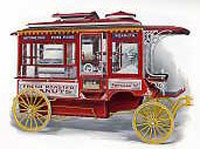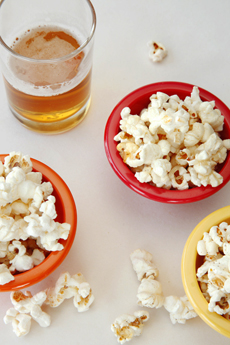It is said that Native Americans brought popcorn to the first Thanksgiving and that the way to eat popcorn at that time was to hold an oiled ear of corn on a stick over the fire, and then chew the popped kernels off the cob.
After learning about popcorn, colonists began enjoying the first puffed breakfast cereal—a bowl of popcorn served with cream or milk.
In the 18th century, after the corn harvest, rendered fat would be thrown into a cast iron pot sitting over an open fire.
When the fat was hot, farmers would toss in corn kernels, a little molasses or other sweetener, and then wait for the corn to pop into a sweet, hot treat.
These days, in place of rendered fat, corn oil and sugar are used to make kettle corn.
|
|

The old fashioned way—popping the kernels off the cob—can be done today in a microwave (photo courtesy Freeday Popcorn). |
By the 1840s, corn popping had become a popular recreational activity in the U.S. By the 1870s, the treat was sold in grocery stores and at concession stands at circuses, carnivals and fairs. In 1885,
Charles Cretors, founder of the Chicago snack equipment company C. Cretors and Co., invented the first commercial popcorn machine, and in 1893 he introduced the first mobile popcorn machine at the Midway of Chicago’s Columbian Exposition.
|
|

Charles Cretors’ popcorn wagon. |
It was reported by the Scientific American that the apparatus weighed about 400 or 500 pounds, and could be easily drawn by a boy, pulled by a small pony or mounted on trucks. The photo of the popcorn wagon at the right is of the improved 1900s version of the original model. The Cretors popper allowed vendors to follow crowds, especially ones near movie theaters, lending itself to the tradition of enjoying the golden fluffs at the cinema.
The Mobile Popper & The Movies
Thanks to the mobile popper, popcorn was very popular from the 1890s onward. Street vendors pushed steam or gas-powered poppers throughout the nation, selling both popped (by the bag or shaped into balls or squares) and unpopped kernels. At about the same time, flickers—or movies—were making their debut. By the early 1920s, popcorn was available at most movie theaters across the country, as much a part of the enjoyment as watching Charlie Chaplin and Greta Garbo.
- At about a nickel per bag or a penny for a popcorn ball, people of all ages enjoyed popcorn and even continued to use the puffed snack as festive decorations.
- Smaller machines were developed, and commercial poppers in theatres appeared in 1912. By 1945, nearly half the popcorn consumed in the United States was consumed in the soft glow of a movie screen.
- By 1951, 96% of all U.S. cinemas sold popcorn in their lobbies. Riding the popcorn wave, home-cooks were inspired to develop recipes for everything from popcorn pudding, fritters and Cracker Jacks to chocolate-covered popcorn and popcorn brittle.
- During the Depression (from 1929 through most of the 1930s), popcorn, at 10 cents a bag, was one of the few luxuries poorer families could afford; so while other businesses failed, the popcorn business thrived.
- When sugar was sent overseas for U.S. troops during World War II (1939 to 1945) and there was so little of it in the States to make candy that Americans ate three times as much popcorn as usual.
The Popcorn Slump
Popcorn went into a slump during the early 1950s, when television became popular and movie attendance dropped. But when the public began eating popcorn at home, the new relationship between television and popcorn led to a resurgence in popularity.
Recovery of the movie industry, which saw its annual admissions double between 1971 and 2002 also helped. In 2004, cinemas sold about 60 million pounds of popcorn, and the average American ate 70 quarts. Today, Americans consume about 17 billion quarts of popped corn each year, with much of it coming from Indiana, with Nebraska producing a large crop as well.
Continue To Page 4: Popcorn Flavors
Go To The Article Index Above




